FIVE cooking appliances that will reduce your number
It’s that time of the year again – back to school and work after a long festive season. While many of us are still enjoying the summer season, this is also the perfect time to get back to thinking about energy saving after days of cooking and baking over the holidays. To help Randburg residents reduce their electricity bills, 49M has provided various energy-saving recipes and tips for cooking.

The Know Your Number campaign by 49M encourages South Africans to be the drivers for social and behavioural change and to encourage everyone to ‘Live Lightly’ in terms of energy efficiency. The campaign helps consumers understand how much their homes are consuming, and assists them in reducing their energy usage by providing the required tools and advice. Small changes easily result in a 10% reduction in household consumption, without having to invest any money upfront.
Your home’s energy rating can easily be calculated by following the steps below, or by visiting the 49M online calculator at www.49M.co.za
Then measure every room in your home to calculate your total floor area.
Take the annual kWh consumption you worked out and divide it by the number of square meters and that will be your number.
Then compare this with the scale provided in this accompanying infographic and you will see how you are doing.
The average household consumes around 1100 kilowatt hours of electricity per month. About 25% of this can be attributed to kitchen appliances.
Here are some of the tips for choosing cooking appliances:
When choosing a stove or hob
Gas hobs require only a small amount of electricity to light them, so choosing a gas hob is a great way to save electricity. Choose ceramic hobs over solid plate ones as they are more efficient. An induction hob uses a magnetic field to instantly heat up the cooking utensil. Due to the technology applied, steel pots are required. Induction plates are widely available and do not require installation.
Slow cookers, pressure cookers and electric frying pans
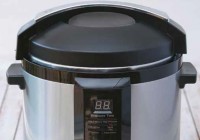 Slow cookers are more energy efficient for dishes such as casseroles, curries and even puddings. They use 300 watt to cook over 3 to 12 hours which is more that 50% less than a traditional oven. Pressure cookers use high pressure to cook food faster and as a result save electricity. Electric frying pans save power due to it heating up much quicker than your traditional stove plate and they are versatile enough for you to prepare most meals.
Slow cookers are more energy efficient for dishes such as casseroles, curries and even puddings. They use 300 watt to cook over 3 to 12 hours which is more that 50% less than a traditional oven. Pressure cookers use high pressure to cook food faster and as a result save electricity. Electric frying pans save power due to it heating up much quicker than your traditional stove plate and they are versatile enough for you to prepare most meals.
Wonderbags
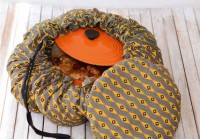 The Wonderbag is a simple heat retention ‘cooker bag’ developed in South Africa which can save 30% on fuel and electricity costs. It cuts down on energy use, because once food has been heated to boiling point, the pot is transferred to the Wonder Bag and the cooking process is completed using the latent heat circulated by the insulation layers of the bag.
The Wonderbag is a simple heat retention ‘cooker bag’ developed in South Africa which can save 30% on fuel and electricity costs. It cuts down on energy use, because once food has been heated to boiling point, the pot is transferred to the Wonder Bag and the cooking process is completed using the latent heat circulated by the insulation layers of the bag.
Microwaves
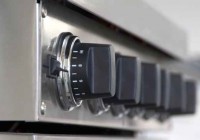 Microwaves use a lot of energy when operating, but because cooking times are so drastically reduced, using a microwave to prepare a meal will reduce energy use to about two-thirds compared with a conventional oven. Convection or fan-assisted microwaves are about 20% more energy efficient than conventional ones. A lightwave oven combines the microwave, grill and convection functions allowing for reduced electricity usage and fasted cooking times
Microwaves use a lot of energy when operating, but because cooking times are so drastically reduced, using a microwave to prepare a meal will reduce energy use to about two-thirds compared with a conventional oven. Convection or fan-assisted microwaves are about 20% more energy efficient than conventional ones. A lightwave oven combines the microwave, grill and convection functions allowing for reduced electricity usage and fasted cooking times
Hayboxes
Hayboxes, also known as retained-heat cooking, use an age-old technique that consumes very little electricity. In the past, hay, feathers or wool were used for insulation. Nowadays, a blanket and a cooler box will suffice. The energy generated in a short time on the stove is then conserved through insulation for up to 24 hours. Food can then be left in the “haybox” until it is ready to serve, and will be piping hot.
Some of the delicious meals taken from the 49M Recipe book can be prepared using some of the above-mentioned gadgets. Click on the links below to view the full recipes:
Oxtails stew with dumplings, cardamom, spiced rice pilaf
Pesto potato salad (pictured below)
Traditional bolognaise sauce

Prawn and chorizo risotto (pictured below)
Moroccan lamb shanks
Easy, pulled pork
Pressure cooker cheesecake
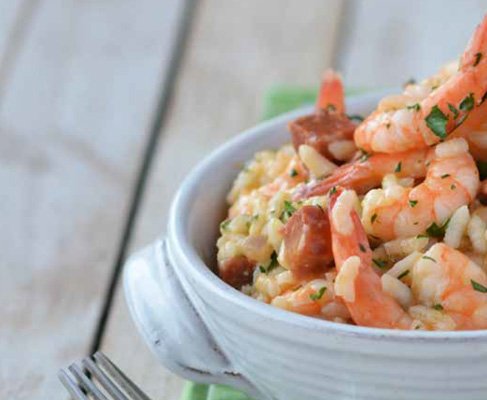
One-pot meals not only save energy and time, but also take a fraction of the time to clean up
Sausages with mushrooms and gravy
Sweet and sour pork (pictured below)
Prawn and noodle stir fry
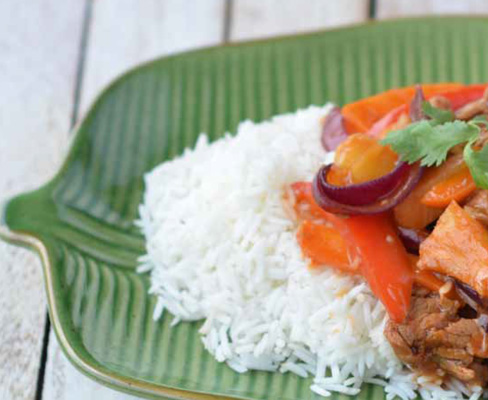
No-roast, roast beef
Cold oven lime and coconut cake (pictured below)
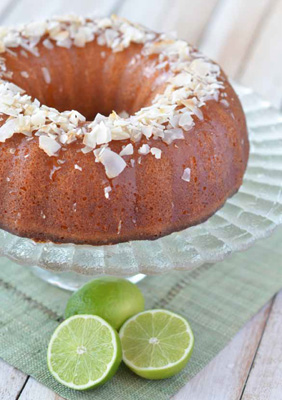
As the country’s power system continues to remain tight it is vital that all South Africans reduce their energy consumption and avoid wastage.
About 49M: The 49M campaign was launched in March 2011 as a response to the country’s constrained power system. The campaign encourages individuals and corporates to lead energy smart lifestyles thereby saving the planet and their pockets. South Africans are encouraged to join the campaign by visiting www.49m.co.za to pledge their support. Go to the 49M Facebook page or tweet @49m_Co_Za.





